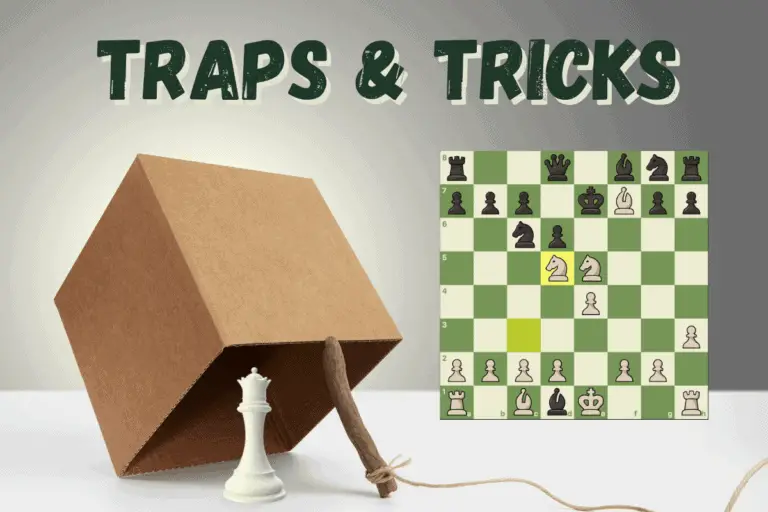Traps for the Queen’s Gambit: [Elephant trap, Rubinstein Trap]
⭐⭐⭐ Take 3 minutes to read and improve your chess game ➡️ : This article was first published on, and is Copyright of Chessquestions.com
The Queen’s Gambit can be a deceptive opening sometimes. Most of the time, it’s safe and solid. However in some lines, there are dangerous traps.
In this article, you’ll see two such traps –
- Elephant Trap
- Rubinstein Trap
You’ll understand the main ideas and the logic behind them as well as how to avoid falling into them. Both of them arise from the Queen’s Gambit Declined variation.
Let’s take a look –
Elephant Trap
It starts with 1.d4 d5 2.c4 e6
This is the Queen’s Gambit Declined, popularly known as QGD.
3.Nc3 Nf6 4.Bg5 Nbd7
This is known as the Cambridge Springs variations. If you notice, Black hangs their d5-pawn for free. This is where the Elephant Trap begins. White continues with
5.cxd5 exd5 6.Nxd5??
Assuming that the d5-pawn is free.
Black’s knight on f6, which is the sole defender of the pawn, is pinned. If it moves, the queen on d8 will be lost.
But is it really free?
Black has a surprise
6…Nxd5!
Leaving their queen enprise.
7.Bxd8
White takes the queen. But unfortunately, they are now faced with an unpleasant check.
7…Bb4+!
The White king
- Cannot escape to a safe square.
- Cannot capture the bishop that is giving a check.
Hence they’re forced to put their queen in the middle to block the check.
8.Qd2
Now Black first captures the queen with a CHECK! This gives them an extra move to
capture White’s bishop on d8.
8…Bxd2+ 9.Kxd2 Kxd8
And now if you count the material, Black has an extra piece. That’s because White lost 3 pieces – a knight(on d5), a bishop (on d8) and queen (on d2), whereas Black lost only 2 –
a bishop (on d2) and a queen (on d8). This gives them a winning advantage.
How not to fall in the Elephant Trap?
Instead of grabbing the pawn with 6.Nxd5, White should continue with 6.e3.
Now they threaten for real to take on d5 on the next move – 7.Nxd5 Nxd5 8.Bxd8 Bb4+ and instead of giving up their queen, White has 9.Ke2, escaping the check.
Therefore Black should defend the pawn either with 6…c6 or 6…Be7. Play continues with enough fight left for both the sides.
Rubinstein Trap
This trap is named after the legendary Abika Rubenstein who fell for it in one of his games against the former world champion Alexander Alekhine.
Here’s their game – Alekhine playing with the White pieces and Rubinstein with the Black.
1.d4 d5 2.Nf3 Nf6 3.c4 e6
Once again the game has transposed to the Queen’s Gambit Declined Variation.
4.Bg5 Nbd7 5.e3 Be7 6.Nc3 O-O
Now some usual developing moves are played by both sides.
7.Rc1 Re8 8.Qc2 a6 9.cxd5 exd5 10.Bd3 c6 11.O-O Ne4
And here the trap starts.
12.Bf4
The bishop retreats and creates a very subtle threat of winning a pawn. Other options aren’t so good.
- 12.Nxe4? is met by 12…dxe4! Now if 13.Bxe7, Black plays 13…Qxe7 supporting the e4-pawn which forks White’s f3-knight and d3-bishop.
Black wins a piece. On the other hand if White takes with 13.Bxe4, they lose a piece after 13…Bxg5 14.Nxg5 Qxg5 -+
- White could try 12.Bxe4, but after 12…dxe4 13.Nxe4 Bxg5 14.Nexg5 Nf8, Black has some compensation in the form of White’s weakened light squares.
In the main game, play continues –
12…f5?
Rubenstein falls into the trap and loses a pawn after
13.Nxd5! since 13…cxd5 is met with
14.Bc7! Trapping the queen on d8.
Rubinstein instead chose to be a pawn down with 13…Bd6 and eventually lost the game.
How to avoid falling into the Rubinstein Trap?
There are 2 ways to avoid this trap that I will show below. One of them starts on the 11th move while the other starts on the 12th move.
Let’s look at the improvement on the 12th move first –
After White plays 12.Bf4, setting up a cunning trap, Black should respond with
12…Ndf6!
This way, they create an escape square for their d8-queen. At the same time, they also protect the central knight on e4. White can try to grab the extra pawn with
13.Nxe4 dxe4 14.Bxe4 Nxe4 15.Qxe4
When Black can continue with
15…Be6!
Black has excellent compensation for the lost pawn in the form of a bishop pair on an open board.
Some of you might not want to try this, since Black remains a pawn down. In that case, you could also refrain from playing 11…Ne4.
The improvement for Black on the 11th move is
11…Nf8
Defending the h7-pawn without making any commitments. The position is equal.
Conclusion
Sometimes, things can be deceptive. There might be more than what meets the eye. This is the case with Elephant Trap and Rubenstein Trap in the Queen’s Gambit. They are so subtle that you might not notice them.
Tread with caution in this opening and remember how not to fall in them. At the same time, you try to use them against your opponent. Since they are so subtle, chances are, anyone who doesn’t know them might fall into it. This would give you a comfortable material advantage.

![Traps for Ruy Lopez: [Mortimer, Noahs Ark, Tarrash, Fishing Pole]](https://chessquestions.com/wp-content/uploads/2021/05/Traps-for-Ruy-Lopez-768x512.png)

![Sicilian Defence Traps: [Magnus smith, Siberian]](https://chessquestions.com/wp-content/uploads/2021/05/Traps-for-Sicilian-Defense-768x512.png)